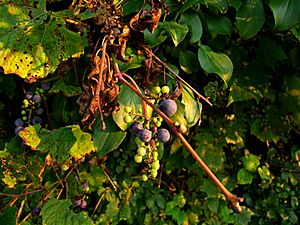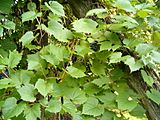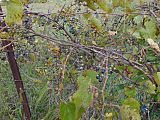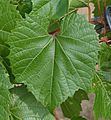Vitis riparia facts for kids
Quick facts for kids Vitis riparia |
|
|---|---|
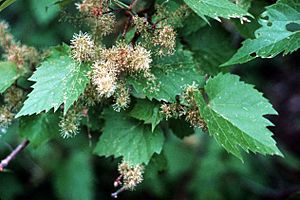 |
|
| Scientific classification | |
| Genus: |
Vitis
|
| Species: |
riparia
|
The riverbank grape (scientific name: Vitis riparia), also known as the frost grape, is a type of vine that grows naturally in North America. This climbing plant is found all over central and eastern Canada and the central and northeastern parts of the United States. You can find it from Quebec down to Texas, and from eastern Montana to Nova Scotia. Some people have reported seeing it in the northwestern USA, but these plants likely grew there after being brought from other places.
The riverbank grape can live for a long time. It can even climb to the very top of the tallest trees. It grows dark fruits that birds and people enjoy. This grape has been used a lot in growing grapes for business. It helps make stronger grapevines by being used as rootstock (the bottom part of a grafted plant) and in creating new types of hybrid grapes.
The name "riverbank grape" comes from its scientific name, Vitis riparia. In Latin, rīpārius means "of riverbanks," and it comes from the word rīpa, which means "riverbank."
Contents
What Does the Riverbank Grape Look Like?
Older riverbank grape vines have loose, cracked bark. Their stems can grow to be several inches thick. The leaves grow in an alternating pattern along the stem. Often, you'll find tendrils (thin parts that help the vine climb) or flower clusters opposite the leaves. The leaves have rough, jagged edges and are usually 5 to 25 centimeters (2 to 10 inches) long and 5 to 20 centimeters (2 to 8 inches) wide. Sometimes, they have a few hairs on the underside of their veins.
Vitis riparia plants are usually either male or female (this is called dioecious). The flowers grow in a loose cluster called a panicle, which is about 4 to 15 centimeters (1.5 to 6 inches) long. The flowers themselves are small, smell nice, and are white or greenish.
The riverbank grape blooms between April and June. In August or September, it produces small, blue-black berry-like fruits, which are actually grapes. These grapes are 6 to 15 millimeters (0.2 to 0.6 inches) wide. They have a powdery coating, are juicy, and have seeds inside. They taste like wine but are usually quite sour and have a fresh, green flavor. They don't have the "foxy" taste found in Vitis labrusca grapes.
Because V. riparia grows in so many places, its appearance can change a lot. Some plants might have white berries, flowers that have both male and female parts, large clusters of grapes, bigger berries, or even sweet fruit. However, some experts think these differences might mean the plant has naturally hybridized with other types of grapes.
Where Does the Riverbank Grape Grow?
The Vitis riparia has the largest natural growing area of all the Vitis species in North America. It can be found across almost the entire eastern half of North America. This includes areas from southern Quebec down to Piedmont, Alabama, and the Carolinas. However, it is not found on the coastal plains or in the western parts of the Great Plains. Different types of this species have been seen as far north as Riding Mountain National Park in Manitoba, Canada. They have also been found as far west as Montana, Nebraska, and North Dakota.
In the wild, this vine grows best in open areas that get a lot of sun and have enough moisture in the soil. You can often find it along riverbanks, in forest clearings, along fence lines, and next to roads. This plant can also grow in many different types of soil.
How Hardy and Resistant is the Riverbank Grape?
Some V. riparia vines are known to survive very cold temperatures, even as low as -57 degrees Celsius (-71 degrees Fahrenheit). The leaves of the plant are usually strong against mildew and black rot. Its roots are also resistant to a tiny insect called phylloxera. However, the berries themselves can sometimes get mildew and black rot if the vine stays wet and humid for a long time.
Uses of the Riverbank Grape
One of the most important ways V. riparia is used in farming is as rootstock for Vitis vinifera grapes (the kind used for most wines). A big benefit of using V. riparia (and its hybrids) is that it resists phylloxera and can grow well in different kinds of soil.
Because this species is very cold hardy and resistant to fungal diseases, it has been used a lot in grape breeding programs. The goal is to pass on these strong genes to domesticated grapes. The French-American hybrid grapes are good examples of these efforts. V. riparia has been used for over a hundred years to create hardy hybrid grapes.
Many V. riparia hybrids are being used and studied today by plant breeders. For example, the University of Minnesota's horticulture program is working to create a grape that can be used for wine and can survive the cold northern climate of the Upper Midwest. Some important grape types that have a lot of V. Riparia in their family tree include Baco noir, Marechal Foch, Triomphe d'Alsace, and Frontenac.
Even though V. riparia is similar to its cousin, Vitis vinifera, it has some features that make it hard to use for making wine on its own. Its berries are small, which means birds often eat them. The fruit is also very acidic (sometimes up to 5% titratable acidity). The juice has a very strong color, and wine made from it can have a fresh, green (or herbaceous) smell. Because of these reasons, it's not usually used by itself for making wine commercially.
However, these grapes are sometimes used at home to make tasty jellies, jams, and wine.
Gallery
- Vitis riparia
-
Botanical garden in Berlin, Germany.
See also
 In Spanish: River Bank Grape para niños
In Spanish: River Bank Grape para niños



